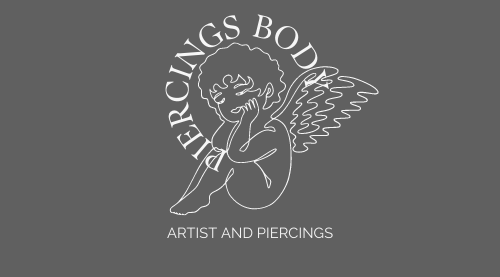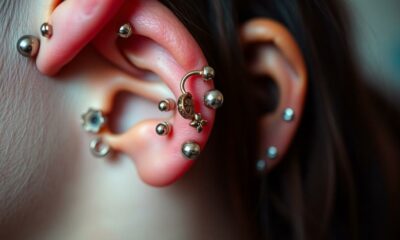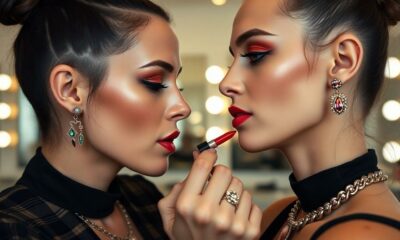Unique Piercing Contexts
Piercings in Competitive Sports: Rules and Workarounds
What are the best strategies for managing piercings in competitive sports without compromising your personal expression? Discover effective workarounds and insights.
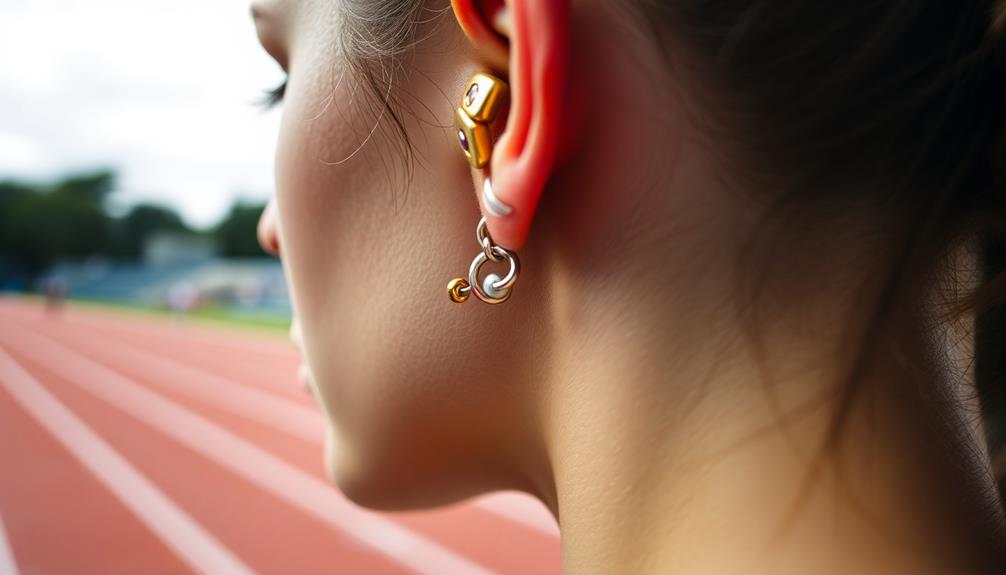
Maneuvering piercings in competitive sports can be tricky, but you can strike a balance between personal expression and safety. Most leagues enforce strict no-jewelry rules to prevent injuries, which means you often have to remove earrings during games. However, some organizations allow soft plastic earrings or sport retainers. Always check specific league rules to avoid disqualification. Open communication with coaches is key, especially if cultural significance influences your choice of piercings. Considering alternatives and advocating for policy changes can also make a difference. Keep exploring to find effective strategies that work for you and others in your sport.
Key Takeaways
- Youth sports organizations enforce strict no-jewelry policies to enhance athlete safety and prevent injuries during competitions.
- Compliance with sport-specific regulations is crucial to avoid disqualification due to prohibited jewelry items.
- Acceptable jewelry options like soft plastic earrings and sport retainers can allow personal expression while minimizing injury risks.
- Proper aftercare and hygiene practices are essential for athletes with piercings to prevent infections during sports participation.
- Open communication between athletes, parents, and coaches is vital for addressing cultural sensitivities and navigating sports jewelry regulations.
Overview of Piercing Regulations
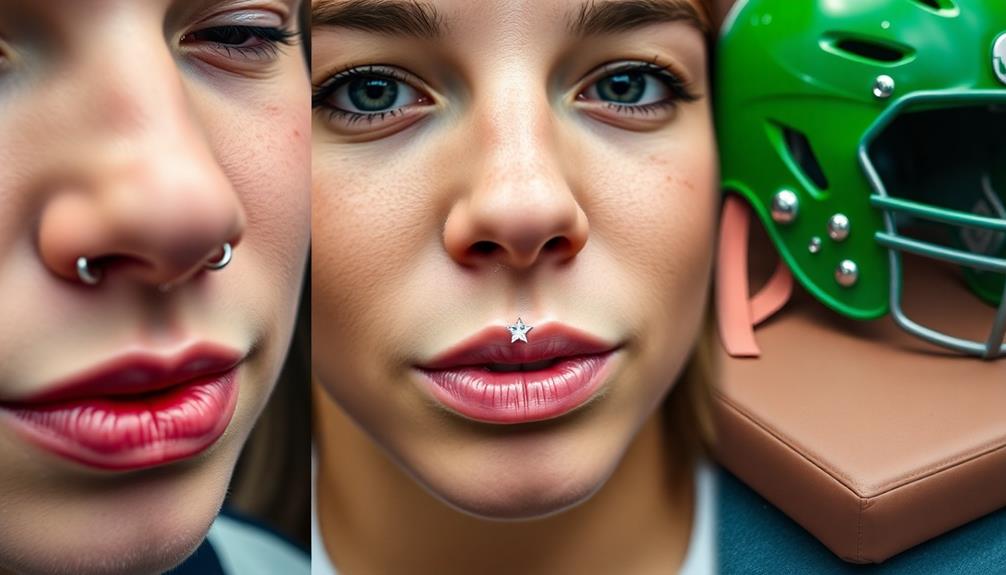
In competitive sports, piercing regulations play an essential role in guaranteeing athlete safety. Most youth sports organizations enforce a strict no-jewelry policy, which includes banning all types of earrings during competitions. This rule is primarily driven by the significant risk of injury that earrings pose, especially in contact sports. Documented cases show that earrings can cause tearing of earlobes or even get entangled in equipment, leading to serious injuries.
Many governing bodies, such as FIFA and USA Water Polo, explicitly outline these jewelry prohibitions in their official rulebooks, highlighting the liability concerns associated with potential injuries. Before games, coaches and referees are responsible for checking athletes for any jewelry, including earrings, and mandatory removal is often required for participation.
While some sports may allow exceptions for specific types of jewelry, like soft plastic earrings or taped piercings, these allowances aren't universally accepted across all competitive leagues. As a result, if you're an athlete with piercings, it's important to familiarize yourself with your sport's regulations to avoid disqualification and guarantee your safety during competitions.
Safety Concerns in Sports
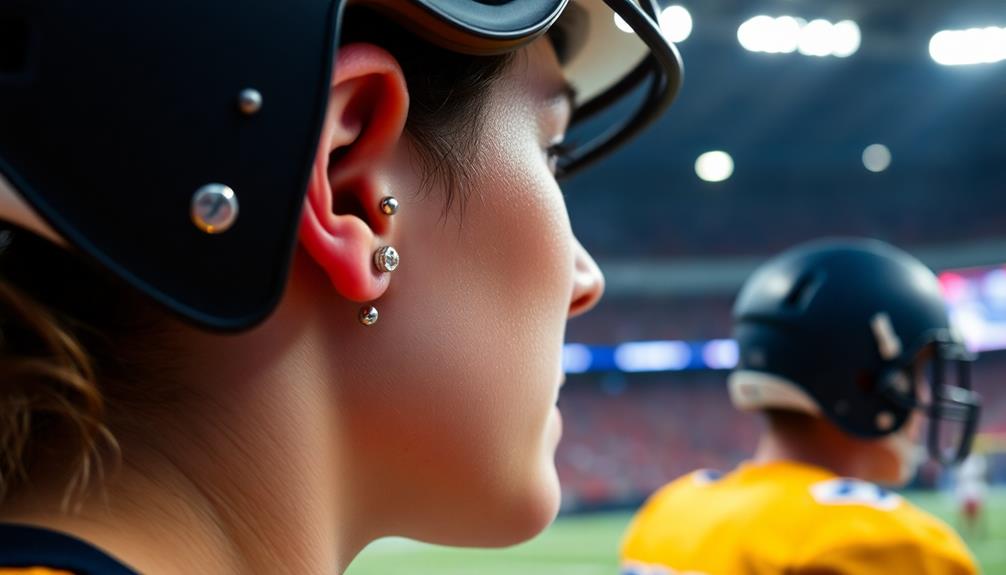
Safety in competitive sports hinges on minimizing risks, and jewelry often poses significant hazards. When it comes to ear piercings, the strict no-jewelry rule in youth sports is enforced to prevent injuries during play. Collisions between players and high-speed balls can lead to serious injuries, especially when earrings are involved.
Studies show that earrings can tear from earlobes, causing bleeding and scarring, and taping them doesn't eliminate the risk. Historical data reveals that injuries from jewelry have led to successful lawsuits against referees, pushing sports organizations to implement strict jewelry policies to reduce liability.
Furthermore, the potential for degloving injuries from rings and entanglements from necklaces further underscores the importance of removing all body jewelry before participating in sports.
The American Academy of Pediatrics recommends the removal of body jewelry, including ear piercings, due to the increased likelihood of infections and complications that can arise from new piercings during physical activities.
Cultural Perspectives on Piercings

Piercings often hold deep cultural significance, marking important rites of passage in various communities. For many, these modifications symbolize identity and tradition, which can clash with the strict rules in competitive sports that prohibit jewelry for safety reasons. This tension highlights the need for understanding and respect for cultural perspectives on piercings.
Here's a quick overview of different cultural views on piercings:
| Culture | Significance of Piercings | Common Piercing Locations |
|---|---|---|
| Indian | Initiation into adulthood | Ears, nose |
| African | Tribal identity and heritage | Ears, lips |
| Indigenous Peoples | Spiritual connection and tradition | Ears, nostrils |
| Western Cultures | Personal expression and fashion | Ears, navel, eyebrows |
Healing periods for new piercings can complicate participation in sports, especially when different communities interpret body modifications differently. Youth athletes may feel excluded when strict no-jewelry policies overlook their cultural traditions. Open communication between parents, coaches, and athletes is essential to balancing safety with respect for these cultural practices, fostering an inclusive environment for everyone involved.
Types of Acceptable Jewelry
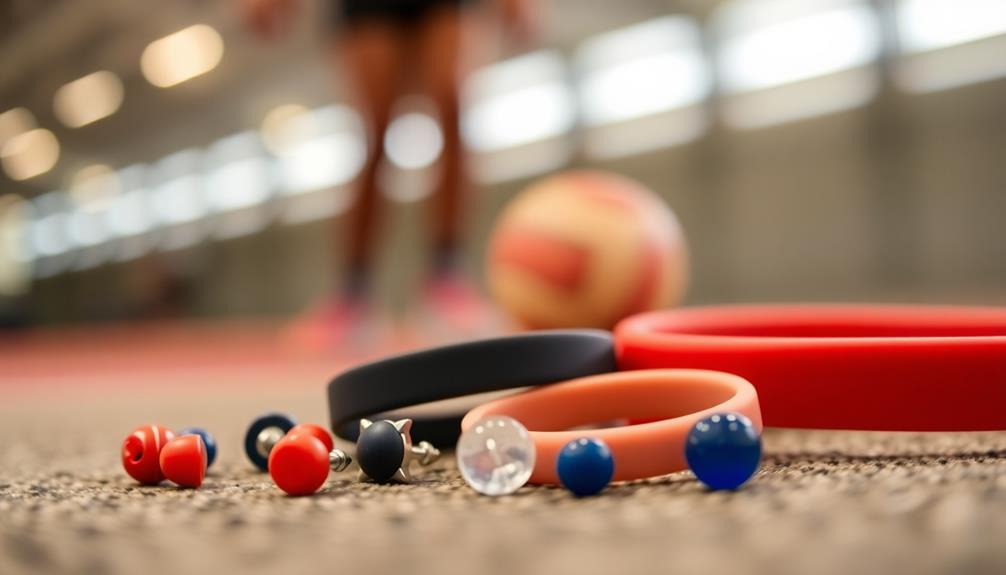
When it comes to acceptable jewelry in competitive sports, safety is your top priority.
You'll find that options like soft plastic earrings or sport retainers meet regulations while allowing for some personal expression.
It's important to understand the cultural considerations and compliance rules that come into play, ensuring you stay injury-free and in line with your sport's guidelines.
Safe Jewelry Options
Finding safe jewelry options for athletes is essential to guarantee both personal expression and injury prevention during competitive sports.
Soft plastic earrings are a fantastic choice for young athletes, as they reduce the risk of injury while still allowing for a bit of flair. If you've got piercings, consider hypoallergenic options like stainless steel or titanium jewelry; these materials help minimize allergic reactions and the risk of infections.
Earring sport retainers have emerged as another protective alternative, enabling you to keep your piercings while reducing injury risks during competition.
If you're looking for something non-piercing, clip-on earrings or magnetic earrings can provide a fashionable way to adhere to safety regulations without sacrificing your style.
Additionally, many coaches and sports organizations recommend using padded or protective earring covers to safeguard existing piercings during practices and games.
Cultural Considerations
Understanding cultural factors regarding body jewelry is essential for athletes participating in competitive sports. Different cultures perceive body piercings differently, with some viewing them as significant rites of passage. This perspective can create tension when sports rules prohibit jewelry during competitions.
While many youth sports organizations enforce strict no-jewelry policies for safety reasons, it's important to acknowledge the cultural significance of personal expression.
Here are some types of acceptable jewelry to take into account:
- Soft Plastic Earrings: These can be a safe alternative for athletes wishing to keep their piercings.
- Sport Retainers: Designed specifically for athletes, these retainers can help maintain piercings while complying with safety regulations.
- Small Stud Earrings: Depending on the sport's specific rules, some may permit non-intrusive jewelry.
- Cultural Symbols: Athletes should discuss with coaches if culturally significant jewelry can be worn safely.
Awareness of these cultural factors can help coaches and administrators create an inclusive environment while ensuring the safety of all participants.
Balancing safety with respect for cultural practices is key in competitive sports.
Compliance With Regulations
Compliance with regulations regarding jewelry in sports is vital for both safety and performance. Many youth sports organizations implement strict no-jewelry rules, including the prohibition of earrings, to minimize injury risks during competition. While this can feel limiting, it's essential to prioritize athlete safety above all.
The most commonly accepted types of jewelry are soft plastic earrings or sport retainers designed specifically to reduce injury risk. However, these alternatives may not be accepted universally across all leagues. Some organizations do allow small, post-style earrings that are less likely to get caught or pulled, provided they're secured properly.
It's important to note that athletes are generally advised to remove all body jewelry before participating, as taping earrings doesn't adequately eliminate risks.
Compliance with regulations can vary considerably by sport, with some leagues making exceptions for cultural or religious items. However, these exceptions typically require prior approval from officials.
Before you compete, always check your league's specific rules regarding acceptable jewelry to confirm you're compliant and ready to focus on your performance.
Aftercare for Athletes

Proper aftercare is essential for athletes with new piercings to guarantee a smooth healing process and prevent infections. Here are some key steps to follow for effective aftercare for athletes:
- Clean the Piercing: Use saline solution to clean the area twice a day. This helps to prevent bacteria buildup.
- Avoid Touching: Don't touch your piercing with dirty hands. Always wash your hands before touching the area to minimize infection risks.
- Watch for Symptoms: Monitor the piercing for signs of infection, such as increased redness, swelling, or discharge. If you notice these symptoms, seek medical attention immediately.
- Stay Out of Water: Avoid submerging your new piercing in pools, hot tubs, or lakes for at least two weeks. This reduces exposure to bacteria that could lead to infections.
Additionally, opt for hypoallergenic jewelry made from materials like titanium or surgical stainless steel during the healing process to decrease the risk of allergic reactions.
Communication With Coaches

You need to communicate openly with your coaches about the safety policies surrounding piercings.
Discussing cultural sensitivities can help create a dialogue that respects both safety and personal expression.
Understanding the impact of emotional dysregulation can aid in managing stress during discussions emotional regulation strategies.
Safety Policy Awareness
Coaches play an essential role in ensuring athletes understand the safety policies regarding piercings in competitive sports.
Clear communication about the strict no jewelry policy is crucial to prevent misunderstandings and emotional distress during competitions. By fostering safety policy awareness, you can help athletes make informed choices.
Here are four important points to discuss with your athletes:
- Injury Risks: Explain the specific safety concerns related to piercings, like how earrings can cause injuries during physical play.
- Past Incidents: Share examples of previous injuries caused by jewelry to promote a culture of safety and accountability.
- Timing for Piercings: Advise athletes on the best times to get piercings, emphasizing the importance of waiting until the off-season to avoid conflicts with safety rules.
- Open Communication: Establish open lines of communication about individual circumstances, such as cultural practices or healing periods for new piercings. This sensitivity can help address safety policies effectively.
Cultural Sensitivity Dialogue
Cultural sensitivity in sports is vital for creating an inclusive environment where all athletes feel respected. When you engage in open communication with your coaches about the cultural significance of body piercings, you help them understand your personal expressions while prioritizing safety.
It's important that you, along with your parents, prepare for these discussions, especially if conflicts arise between cultural practices and sports rules. Emphasizing respect and understanding can lead to more productive conversations.
By fostering a dialogue with your coaches, you promote an inclusive atmosphere that acknowledges and values your cultural background. This can potentially result in exceptions or alternatives to strict rules on piercings.
Establishing clear channels for these discussions enhances the collaboration between parents, athletes, and coaches, strengthening overall team dynamics.
Moreover, it's essential for coaches and sports organizations to receive training on cultural sensitivity. This training can equip them to navigate conversations about body modifications like piercings effectively, ensuring that every athlete feels heard and respected.
Compromise Solutions Exploration
How can athletes effectively communicate their need for body piercings while addressing safety concerns? Open dialogue with your coaches is essential. By sharing your perspective, you can emphasize the importance of personal expression and cultural practices while also being mindful of safety.
Here are some compromise solutions to contemplate:
- Soft Plastic Earrings: Suggest using soft plastic earrings that minimize injury risk while allowing you to wear jewelry.
- Protective Gear: Discuss innovative protective gear that could make it safer for athletes to wear piercings during practice.
- Trial Period: Propose a trial period for wearing specific jewelry types during practices. This allows everyone to evaluate safety and comfort without jeopardizing competitive integrity.
- Emotional Impact: Highlight the emotional toll on young athletes when forced to remove jewelry. This can be a compelling argument for reconsidering strict no-jewelry rules.
Advocacy for Policy Changes

Advocacy for policy changes regarding piercings in competitive sports is essential for creating a balance between safety and personal expression. Many athletes view ear piercing as a cultural rite of passage, and it's important to acknowledge this while addressing safety concerns.
By collaborating with organizations and parents, you can propose alternative safety solutions, such as soft plastic earrings or protective covers. This way, athletes can participate without risking injury.
Engaging with sports governing bodies to review strict no-jewelry rules opens a dialogue that considers both safety and diverse cultural practices surrounding body modifications. You and other advocates can push for guidelines that allow medical exemptions or specific accommodations for newly pierced ears during off-season periods.
Educational campaigns highlighting the low incidence of injuries related to earrings in youth sports can further support your calls for more lenient rules. These efforts foster an environment that values inclusivity and individual expression, showing that safety doesn't have to come at the cost of personal identity.
Your advocacy for policy changes can help reshape the conversation around piercings in competitive sports, creating a more accepting atmosphere for all athletes.
Alternatives and Workarounds

Finding effective alternatives and workarounds for piercings in competitive sports can help athletes maintain their personal expression while prioritizing safety.
Here are some options to evaluate:
- Soft Plastic Earrings: These are emerging as a safe alternative, allowing you to express your style without the risk of injury during contact sports.
- Earring Sport Retainers: These devices can secure your earrings, reducing the chances of them being pulled out or causing harm during play.
- Postpone New Piercings: If you're contemplating new piercings, wait until the off-season. This guarantees they've ample time to heal, preventing complications during competitions.
- Innovative Protective Padding: Look for new padding options, beyond traditional band-aids, to cover your earrings during games.
This approach enhances safety while allowing you to showcase your personal style.
Frequently Asked Questions
Can Athletes Wear Piercings During Practice Sessions?
You can generally wear piercings during practice sessions, but it's best to check with your coach or facility rules. They might have specific guidelines to guarantee everyone's safety and maintain a focused training environment.
What Types of Earrings Are Considered Safe?
You can't just wear any earrings! Look for lightweight studs or small hoops made of materials like titanium or surgical steel. They're comfy, safe, and won't turn your ears into a wrestling ring during practice!
Are There Exceptions for Religious or Cultural Piercings?
Yes, there're often exceptions for religious or cultural piercings in various competitions. You should check specific regulations, as some organizations allow these piercings, while others may require documentation or specific accommodations for participants.
How Can Parents Support Their Pierced Athletes?
Supporting your pierced athlete means embracing their individuality. You can help by discussing rules, encouraging open communication with coaches, and finding safe alternatives for jewelry. Together, you'll navigate challenges while celebrating their unique expression and passion.
What Happens if an Athlete Gets Injured Due to a Piercing?
If you get injured due to a piercing, it can complicate your recovery. You might face increased pain or infection risks. Always consult a medical professional for the best course of action to guarantee proper healing.
Conclusion
In the world of competitive sports, steering through piercing regulations can feel like running a race with hurdles. While safety is paramount, it's essential to recognize the cultural significance of personal expression. By communicating openly with coaches and advocating for policy changes, you can champion a more inclusive environment. Remember, just as athletes adapt their strategies on the field, you can find creative workarounds that allow you to shine, proving that individuality and competition can coexist beautifully.
Hi, my name is Danielle, and I’m an author for piercings-body.com. I have a passion for writing and love to share my knowledge on all things body piercing-related. I’m also a huge advocate for safe body modification practices and believe everyone should be able to make informed decisions about their bodies. When I’m not writing or blogging, I enjoy spending time with my family and friends, practicing yoga, and exploring new places.
Unique Piercing Contexts
The Role of Piercings in Various Subcultures: From Punk to Modern Primitives
Cultural expressions through piercings reveal deep connections to identity and rebellion; discover how these body art forms have evolved and captivated diverse communities.
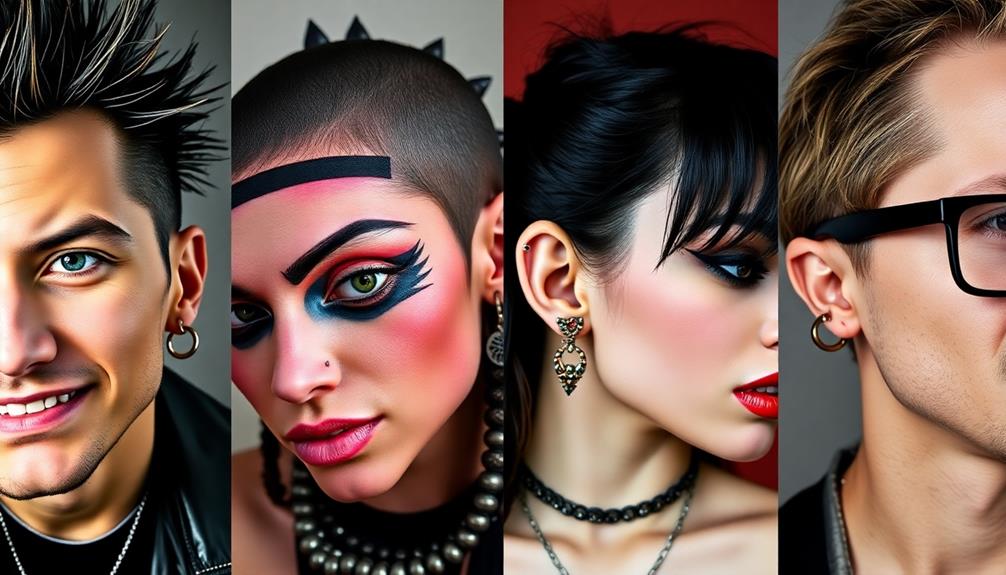
Piercings play an essential role in expressing identity and rebellion across subcultures, from punk to modern primitives. You'll notice how punk culture transformed body piercings into bold statements of defiance, with iconic styles like safety pin septum piercings symbolizing nonconformity. As society shifted, piercings evolved from symbols of rebellion to mainstream fashion staples, thanks to influences from pop culture and social media. Today, trendy styles like microdermal piercings reflect personal exploration and creativity. The journey of piercings is rich and varied, so stick around to uncover more insights about their cultural significance across different communities.
Key Takeaways
- Piercings have historical significance, dating back over 5,000 years, with cultural expressions seen in ancient civilizations and military practices.
- Punk culture popularized piercings as symbols of rebellion, individuality, and nonconformity, influencing various countercultural movements.
- The mainstream acceptance of piercings grew in the 1990s, with celebrities normalizing body modifications and influencing youth culture.
- Contemporary trends reflect diverse styles, with septum piercings symbolizing feminist ideals and hip-hop artists embracing expressions of gender fluidity.
- Social media and fashion industry influence have fostered community around piercings, normalizing body art and creating inclusive cultural dialogues.
Historical Context of Piercings
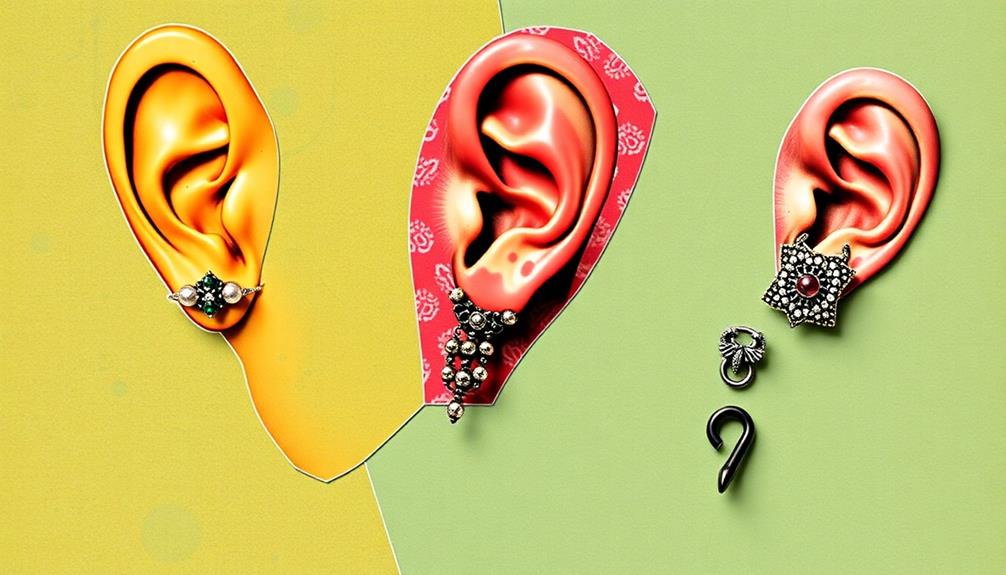
Piercings have adorned human bodies for over 5,000 years, showcasing a rich tapestry of cultural significance. From ancient civilizations, like Ötzi the Iceman, who'd ear piercings and tattoos, to Roman soldiers, nipple piercings symbolized masculinity and military unity.
You can trace the fascinating evolution of body modification through time, as ancient India showcased genital piercings long before the term "Prince Albert" even existed.
After World War II, piercing began to emerge in Western culture as a form of self-identity expression, especially within gay subcultures. This marked a shift in perception, as more people started to see body modification as a way to assert individuality and challenge societal norms.
The punk movement embraced piercings in the late 20th century, bringing them even more into the limelight. Iconic styles, like the safety pin septum piercing, emerged as powerful symbols of rebellion against mainstream ideals.
Understanding this historical context of piercings allows you to appreciate their deeper meanings across cultures and eras, illustrating how body modification has always been a form of personal and collective expression.
Punk and Counterculture Influence
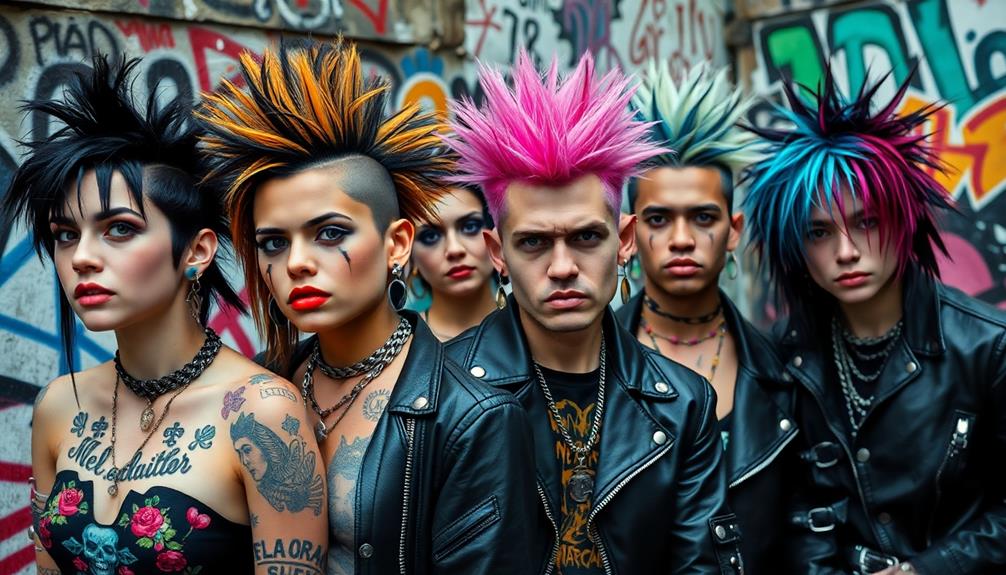
Punk culture transformed body piercings into a bold statement of identity and rebellion against societal norms.
By sporting piercings like the iconic safety pin septum, you're not just making a style choice; you're embracing a movement that challenges the status quo.
This aesthetic continues to inspire modern expressions of individuality and defiance within various countercultures today.
Punk Aesthetic and Identity
In the vibrant world of counterculture, the punk aesthetic revolutionized personal expression through body modifications like piercings, making them powerful symbols of rebellion and individuality. Piercings became a visual representation of nonconformity, with safety pin septum piercings standing out as iconic elements of the punk movement. Influenced by the DIY ethos, you might experiment with various styles and materials, embracing body adornment as an essential part of your identity.
Punk icons like Sid Vicious and Joan Jett showcased multiple piercings, inspiring you and others to see body modifications as a form of personal expression. The modern primitives movement, led by figures such as Fakir Musafar, introduced tribal influences, further enriching the punk aesthetic.
Here's a quick look at how piercings play a role in punk identity:
| Aspect | Description | Example |
|---|---|---|
| Symbolism | Represents rebellion and nonconformity | Safety pin septum piercing |
| Personal Expression | A way to showcase individuality | Unique piercing styles |
| Cultural Solidarity | Solidarity with marginalized communities | Piercings as resistance |
Rebellion Through Body Modification
While mainstream society often views body modifications as mere trends, they've become profound acts of rebellion within punk and counterculture circles. Punk culture, which emerged in the 1970s, embraced piercings as a radical departure from societal norms. The iconic safety pin septum piercing became a powerful symbol of defiance, allowing individuals to challenge the status quo boldly.
As you explore the world of body modification, you'll notice that these piercings serve as visual identifiers for various countercultural groups. They express individuality and demonstrate a rejection of conventional values. The punk movement laid the groundwork for this transformation, inspiring a new generation to use body art as a statement of anti-establishment sentiments.
The rise of modern primitives further expanded the boundaries of piercing, mixing traditional practices with contemporary body art. By the 1990s, body modification surged in popularity, especially among youth seeking to assert their identities.
Today, the significance of piercings continues to evolve, integrating punk influences while embracing diverse expressions of identity across various communities. In this way, body modification remains a powerful tool for rebellion and self-expression.
Mainstream Acceptance of Piercings
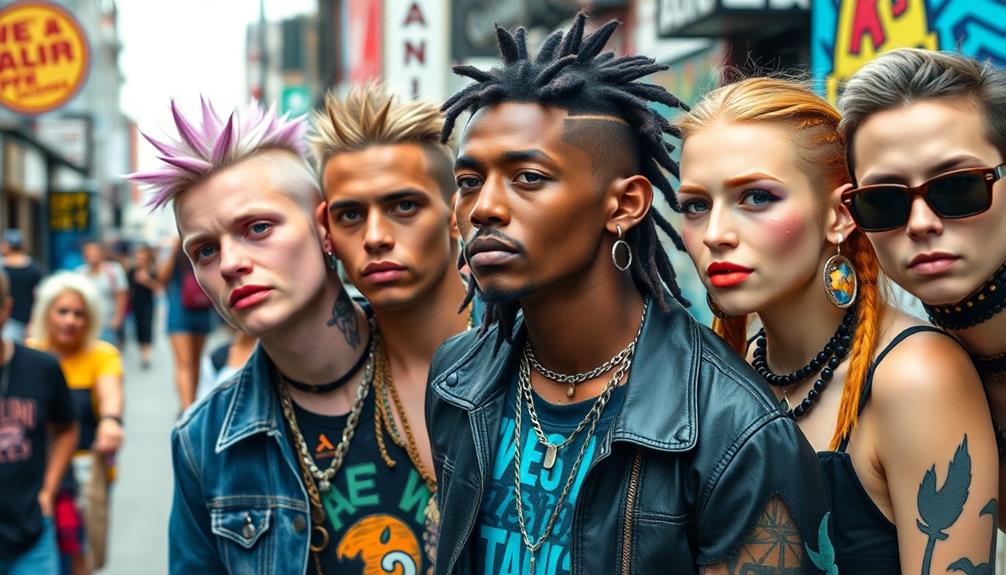
You've likely noticed how piercings have shifted from symbols of rebellion to trendy statements in mainstream culture.
The fashion industry has played a huge role in this change, with high-profile designers embracing body art in their collections. This evolution reflects a broader acceptance of self-expression, making piercings a common form of personal style.
Additionally, similar to how pet care has evolved to accommodate diverse needs, society's attitude towards personal body modifications has embraced a wider array of expressions and preferences, including safe practices and health considerations in body art proper diet and care for pets.
Shifting Cultural Perceptions
Over the years, societal views on piercings have evolved dramatically, shifting from niche subcultures to mainstream acceptance.
In the 1990s, popular body piercings like navel piercings gained traction, largely thanks to stars like Britney Spears and Christina Aguilera. Their influence helped normalize piercing culture, making it popular among youth.
The rise of professional piercing studios, established in the late 1970s, laid the groundwork for safe practices that increased public trust. As these studios flourished, acceptance grew, paving the way for a broader appreciation of body piercings.
Here are a few factors that contributed to this shift:
- Celebrity Influence: Public figures showcased piercings, making them more relatable.
- Fashion Integration: Major designers began to feature diverse piercing styles, blending subculture with high fashion.
- Social Media: Platforms allowed for a sharing of piercing styles and experiences, normalizing them further.
- Cultural Dialogues: Conversations around body modification became more inclusive, welcoming various expressions.
As a result, piercings are no longer just a mark of rebellion; they've become a form of personal expression embraced by many.
Fashion Industry Influence
The fashion industry has played a pivotal role in cementing piercings as a staple of contemporary style. In the 1990s, navel piercings surged in popularity, largely thanks to pop stars rocking crop tops. This trend marked a significant change toward the mainstream acceptance of body piercings as a fashion statement.
Designers like Louis Vuitton and Givenchy have embraced diverse piercing styles, including septum and lip piercings, further normalizing body modifications within high fashion. The allure of celebrity events has also contributed to the fascination with piercings, as public figures often showcase their unique styles on red carpets and social media.
The rise of piercing studios and professional services since the late 1970s has also facilitated this acceptance. As celebrities like Britney Spears and Christina Aguilera flaunted their piercings in the early 2000s, youth culture adopted these styles, making them essential elements of personal expression.
Today, contemporary fashion shows showcase models adorned with multiple piercings, highlighting the evolving perception of body art. It's no longer just seen as an alternative choice; it's a legitimate form of self-expression that resonates within the fashion narrative.
You'll find that piercings have progressed from subcultural symbols to must-have accessories, reflecting a broader cultural acceptance and appreciation for individuality in style.
Contemporary Cultural Significance

Piercings today carry a profound cultural significance that transcends mere aesthetics, intertwining with various subcultures and social movements. As you explore this dynamic landscape, you'll notice how body piercing has become a visual bridge connecting diverse identities.
Here are some key aspects to reflect on:
- Feminist Expression: Septum piercings, a major trend, often symbolize feminist ideals, rooted in both punk culture and tribal influences.
- Gender Fluidity: The rise of hip-hop artists, like Young Thug, incorporating piercings into their fashion reflects growing acceptance of gender-fluid expressions.
- Social Media Impact: Increased visibility on platforms like Instagram and TikTok shapes contemporary cultural significance, allowing influencers to redefine piercing norms.
- Personal Discovery: The variety in styles—from clip-ons to extreme stretching—highlights your ongoing journey of self-expression and identity formation.
In piercing studios, you can find a community that embraces individuality and creativity.
As you engage with these trends, remember that body piercing is more than just a fashion statement; it's a powerful tool for connection and expression in today's society.
Evolution of Piercing Trends
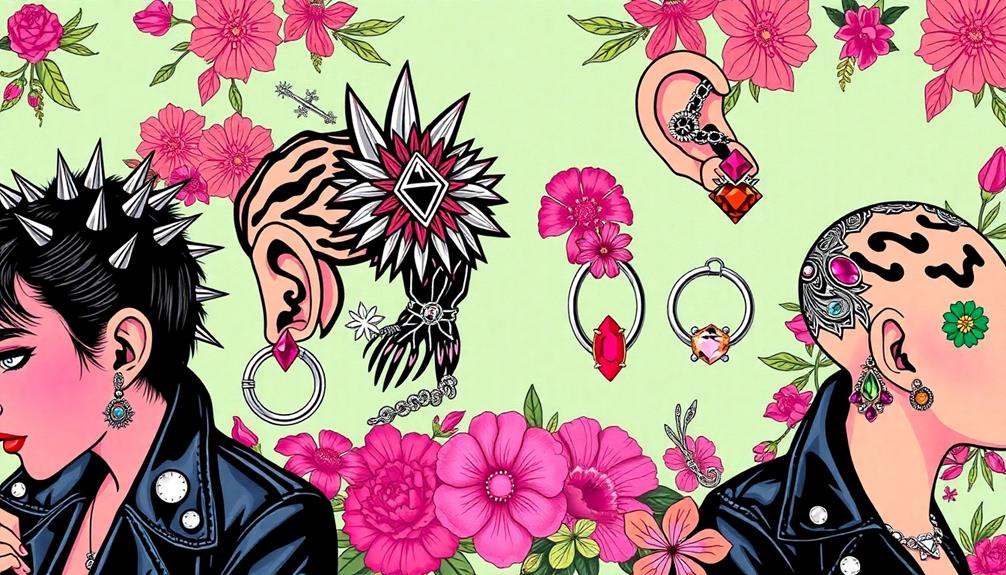
As body piercing continues to serve as a powerful form of self-expression, its trends have evolved considerably over the decades. The journey began in 1978 when Jim Ward opened the first piercing studio in West Hollywood, marking a significant change from a marginal practice to mainstream acceptance.
Fast forward to the 1990s, and you'd see navel piercings surge in popularity, thanks to pop stars flaunting crop tops—this became a symbol of youthful rebellion. Punk culture also played a pivotal role, with styles like safety pin septum piercings emerging as icons of individual expression.
Enter the 2010s, and you witness the explosion of piercing trends fueled by celebrity influence and social media. Platforms helped normalize and diversify piercings in popular fashion, making them accessible across various demographics.
Today, the evolution of piercing trends continues with microdermal piercings and elaborate curated ear styles leading the way. These contemporary choices reflect not only personal expression but also a shift in how society perceives body art.
As you explore these trends, consider how they resonate with your own sense of identity and style.
Types of Popular Piercings
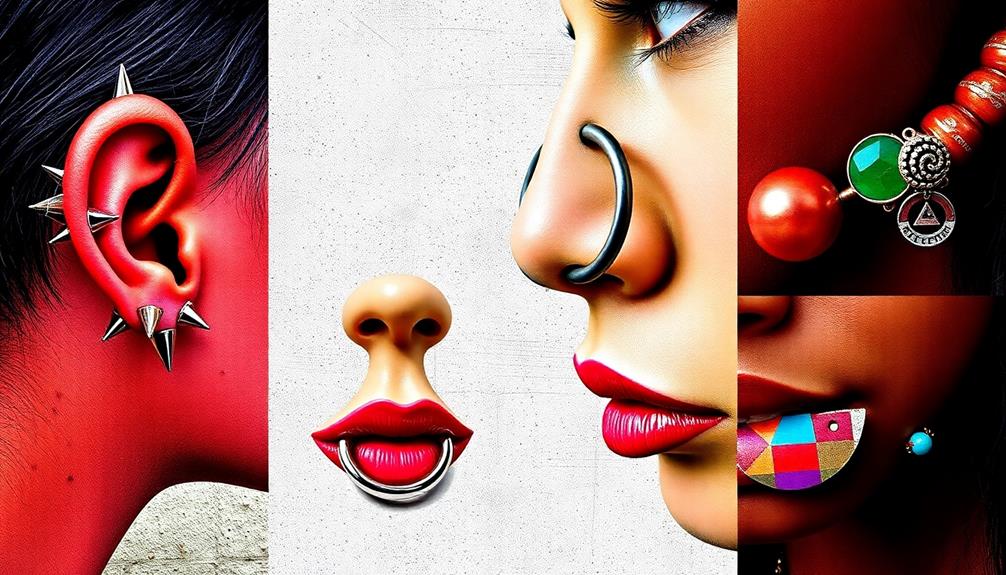
Often, you'll find that ear piercings top the list of popular body modifications. With an average of five appointments per day at piercing studios, styles like helix, tragus, and conch piercings are highly sought after.
These modifications allow for creativity and personal expression, making them a staple in many subcultures.
Here are four popular types of piercings you might consider:
- Ear Piercings: Beyond traditional lobe piercings, options like helix and tragus have gained traction, appealing to various styles and tastes.
- Septum Piercing: This piercing has surged in popularity, often seen as a statement of individuality and self-expression, particularly within punk and feminist circles.
- Navel Piercings: Once a symbol of rebellion in the 1990s, these piercings continue to attract those influenced by pop culture and fashion trends.
- Facial Piercings: Including nose, eyebrow, and lip piercings, these have found their way into mainstream fashion, showcasing a blend of cultural influences.
Each of these piercings speaks volumes about personal style and cultural identity, resonating with diverse subcultures.
Future of Piercings in Society

With a growing acceptance of body modifications, the future of piercings looks bright and vibrant. As more individuals recognize the value of diversification in personal expression, you're likely to see ongoing experimentation with styles, placements, and materials that reflect diverse cultural influences.
The increasing popularity of body art, including piercings, parallels trends in investment practices like Gold IRAs, where cost-effective options are sought for financial growth. As piercings gain increased visibility in media, fashion, and celebrity culture, the normalization of body modifications continues to expand across various demographics.
Social media platforms play an essential role in shaping piercing trends. They allow you to discover new styles and foster a sense of community around body art. This rapid dissemination of ideas keeps the conversation alive and encourages individual creativity.
Moreover, there's a strong emphasis on inclusive representation in body modification practices. This guarantees that piercing remains a dynamic form of self-expression for people from all backgrounds.
As technology advances, the development of biocompatible materials and innovative piercing techniques will likely enhance safety and expand your options for body art.
In this evolving cultural landscape, the future of piercings promises to be diverse, creative, and deeply personal, inviting everyone to embrace their unique identities through body modifications.
Frequently Asked Questions
Why Do Punks Have Piercings?
Punks have piercings to express their individuality and defy societal norms. You'll notice they choose unconventional materials and placements, using body art as a powerful statement against mainstream culture and to showcase their unique identity.
What Is the Cultural Significance of Piercings?
Throughout history, piercings've symbolized identity, rebellion, and status. Today, they express individuality and challenge norms. When you choose a piercing, you're embracing a tradition that intertwines personal expression with cultural significance, connecting you to diverse histories.
What Is the Purpose of Different Piercings?
Different piercings serve various purposes, like self-expression, cultural identity, or spiritual connections. They can symbolize rebellion, enhance aesthetics, or mark important life milestones. Ultimately, it's about what resonates with you personally and uniquely.
What Is the Significance of Piercings?
Did you know that over 20% of Americans have body piercings? Piercings symbolize personal expression, identity, and individuality, allowing you to challenge societal norms while showcasing your beliefs, style, and connection to various cultural influences.
Conclusion
In a world where individuality is celebrated, it's ironic how something as personal as a piercing can become a trend. You might think you're expressing your unique self, yet you're often just joining a crowd—be it punks or modern primitives. As society moves forward, the very act of piercing might lose its rebellious edge, transforming from a bold statement to just another accessory. So, are you really breaking boundaries, or simply following the latest fashion?
Hi, my name is Danielle, and I’m an author for piercings-body.com. I have a passion for writing and love to share my knowledge on all things body piercing-related. I’m also a huge advocate for safe body modification practices and believe everyone should be able to make informed decisions about their bodies. When I’m not writing or blogging, I enjoy spending time with my family and friends, practicing yoga, and exploring new places.
Unique Piercing Contexts
Piercings in Prison: Regulations, Methods, and Meanings
Piercings in prison present unique regulations and methods that reveal deeper meanings; discover how inmates navigate identity amidst strict constraints.
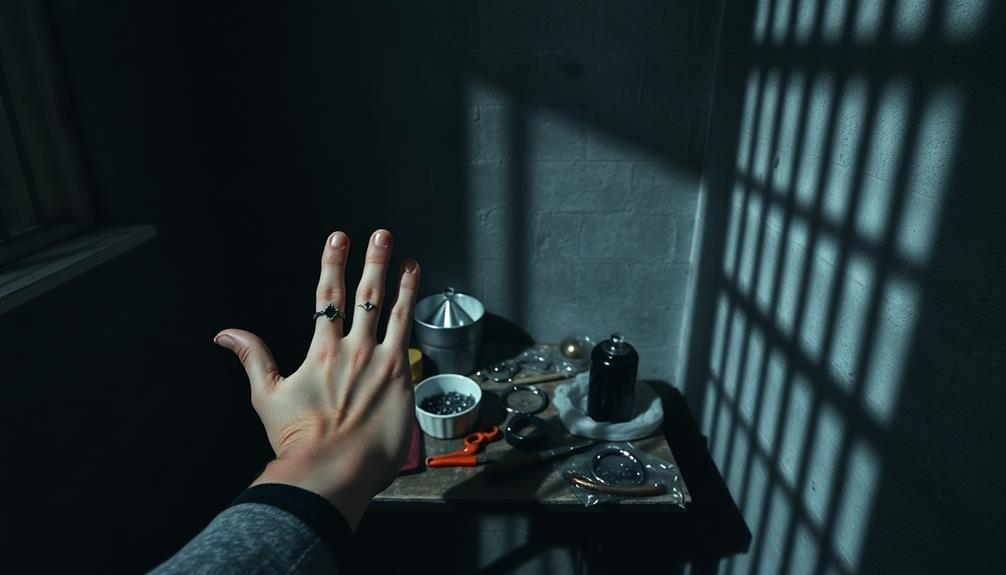
When it comes to piercings in prison, you'll find strict regulations in place. Generally, body piercings are considered contraband due to security concerns, leading to their removal upon entry. Some facilities may allow plastic alternatives. Inmates often flip septum piercings up inside the nose or cover them temporarily when necessary. Piercings can signify rebellion and personal expression, deeply impacting an inmate's identity. However, unsanitary conditions can pose health risks during removal. Understanding the policies surrounding piercings can help you navigate this complex issue and maintain a sense of self in challenging circumstances. There's much more to explore on this topic.
Key Takeaways
- Body piercings are often classified as contraband in prison, requiring removal or substitution with plastic alternatives for safety.
- Concealment methods include flipping septum piercings, using tape, or complete removal to comply with facility regulations.
- Piercing removal can lead to identity loss and emotional distress, highlighting their significance as personal expression for inmates.
- Health risks such as infections may arise from improper removal, necessitating immediate medical attention for any complications.
- Inmates have rights regarding medical care and can file complaints for loss or damage to piercings during removal or transfer.
Overview of Piercing Regulations
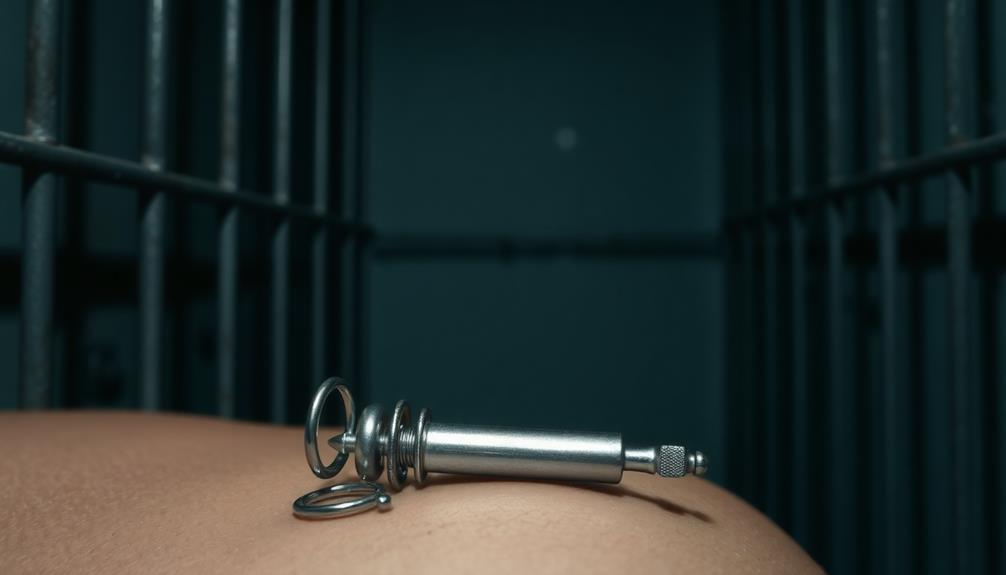
When it comes to piercing regulations in prison, understanding the rules is vital for inmates. Many facilities classify body piercings as contraband due to security risks associated with metal, meaning you'll likely have to remove them upon entry.
However, depending on the specific regulations of your facility, you might be permitted to use plastic or non-metal alternatives for your piercings.
It's important to make sure you know the policies that apply to your location, as they can vary greatly by state and institution. For example, septum piercings can often be flipped up to conceal them, while other types may require complete removal or covering.
Staff may also provide specific guidelines for managing your piercings, so don't hesitate to ask about any concerns you have.
If you face healing issues related to your piercings, it's advisable to communicate with medical personnel to receive proper care.
Being informed about these regulations not only helps you avoid potential conflicts but also allows you to express your individuality within the limits set by the prison environment.
Methods of Concealing Piercings
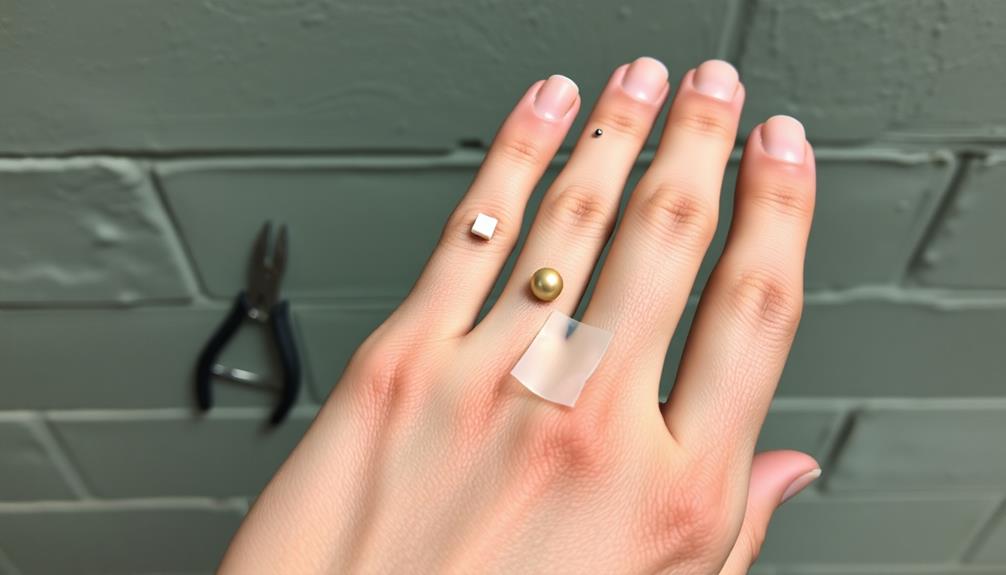
Concealing piercings in prison can be a tricky task, but there are effective methods to manage them discreetly. For septum piercings, one effective technique is to simply flip the jewelry up inside your nose, making it nearly invisible to guards and staff.
However, other types of piercings often require more drastic measures. Complete removal is sometimes necessary, and in such cases, you might need to cover the site with tape or bandages as a makeshift solution.
Some facilities provide specific guidelines on how to manage and conceal piercings while adhering to security protocols, so it's crucial to familiarize yourself with those rules.
If you're experiencing healing issues after removing piercings, don't hesitate to communicate with medical staff; they can help you avoid infections and guarantee proper care.
In certain facilities, the use of plastic or non-metal alternatives for piercings may be allowed, which can minimize security risks while still allowing you to express yourself.
Always stay informed about the regulations in your facility and adapt your methods accordingly to guarantee your safety and compliance.
Psychological Impact on Inmates
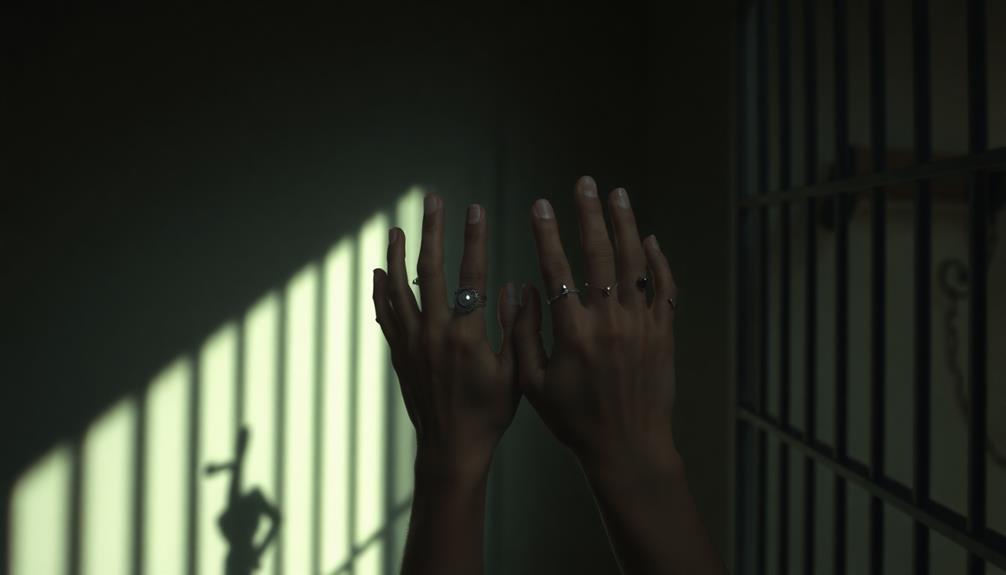
The removal of piercings upon entering prison can trigger profound psychological effects, leaving many inmates feeling a significant loss of identity. These body modifications often serve as personal expressions, and losing them can lead to distress and a disrupted sense of self. You're not just losing jewelry; you're losing part of who you are.
In the prison environment, peer pressure can shape your decisions about body piercings. You might feel the push to conform to the norms or, conversely, rebel against them. This tension can create emotional struggles as you navigate your identity within the confines of prison culture.
Support groups can help address the emotional implications of losing piercings. Engaging in discussions with fellow inmates fosters community and allows you to share your feelings about this loss.
| Psychological Effects | Coping Mechanisms |
|---|---|
| Loss of identity | Support groups |
| Feelings of distress | Open discussions |
| Disruption of self | Creative expression |
| Peer pressure | Finding common ground |
| Need for belonging | Building friendships |
Understanding these impacts can help inmates cope with the changes and reclaim parts of their identity.
Cultural Significance of Piercings
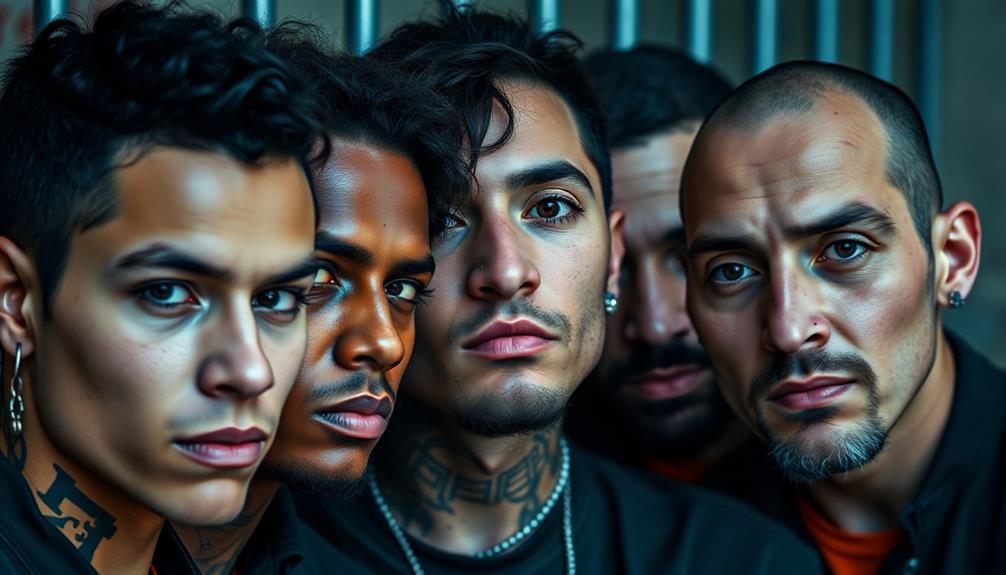
Adjusting to life in prison often means confronting not just the loss of piercings but also their cultural significance. For many inmates, piercings symbolize rebellion and personal expression, reflecting identities formed before incarceration.
You might notice that the meaning of piercings can shift dramatically among different demographic groups. Some inmates view them as markers of status or affiliation within the complex prison hierarchies.
In this environment, you may feel pressure to alter your appearance. Removing piercings could become a way to fit in, leading to a sense of identity loss and distress. While tattoos often find greater acceptance as permanent forms of self-expression, piercings are seen as more temporary and less meaningful. This preference can leave you feeling disconnected from your past.
However, discussions about piercings can also create bonds among inmates. Sharing stories about your piercings and the experiences that shaped your choices fosters a sense of community.
In this shared space, cultural backgrounds and personal histories come together, revealing the deeper significance of body modifications in a world where expression is often restricted.
Health Risks and Legal Issues
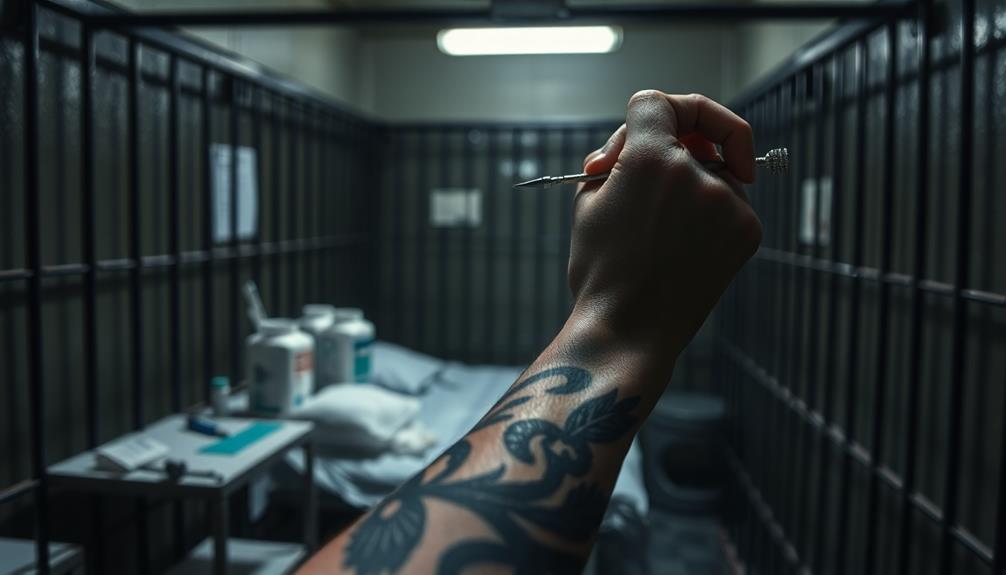
When you consider getting piercings in prison, it's crucial to be aware of the health risks, like infections from unsanitary removal.
You also need to navigate the legal regulations that often classify metal piercings as contraband, which could lead to disciplinary actions.
Understanding your rights regarding body modifications can help you make informed choices during your incarceration.
Health Risks of Infections
Inmates face considerable health risks from infections related to piercings, especially if they're removed improperly or lack proper medical care during healing.
The prison environment often presents unsanitary conditions that can increase the likelihood of infections during the removal process. If you or someone you know experiences complications like swelling, redness, or discharge after a piercing, it's imperative to seek medical attention immediately. These symptoms can indicate an infection that medical staff must address.
Policies surrounding the removal of piercings can vary greatly by facility, affecting the availability of necessary medical resources. Some prisons may have strict rules that complicate timely medical intervention.
Understanding your rights regarding body modifications is essential; if you're aware of these rights, you can better advocate for the care you need.
Without adequate medical attention, even minor infections can escalate, leading to serious health issues. Being proactive about your health is fundamental, so don't hesitate to report any concerns about your piercings.
Legal Regulations Overview
Understanding the legal regulations surrounding piercings in prison is essential for maneuvering the complexities of body modifications while incarcerated. Many facilities classify piercings as contraband due to the security risks associated with metal, including their potential use as weapons. This often leads to mandatory removal upon entry, which can pose significant health risks if removal practices aren't sanitary. Infections and complications during the healing process can arise, making it vital to be aware of how piercings are handled.
Legal implications regarding piercings can vary widely by state and facility. Some prisons may allow non-metal alternatives, while others might strictly prohibit all forms of body modifications. Policies typically align with the prison's security protocols and your behavior, affecting your ability to keep or receive personal items like piercings.
Importantly, you have the right to communicate any health concerns related to your piercings to medical staff. This underscores the need for awareness regarding your rights and the procedures in place for body modifications. Understanding these regulations can help you navigate the challenges of expressing your identity while adhering to prison policies.
Rights of Inmates
Steering through the complexities of piercings in prison also involves knowing your rights, especially concerning health risks and legal issues. You have the right to medical attention for any health risks that arise from unsanitary removal or neglect of your piercings, which can lead to infections needing treatment.
It's essential to understand that legal implications of possessing piercings can vary considerably between states and facilities. Many institutions classify them as contraband, often enforcing removal upon entry.
You should stay informed about your rights regarding body modifications since policies on piercings differ greatly across various prison systems. These policies can impact your ability to express yourself personally.
If a piercing becomes infected, it's important to communicate promptly with medical staff for appropriate care, reinforcing your health rights within the prison environment.
Additionally, if you experience loss or damage to your piercings during the removal process, you can file complaints through the prison's complaints system. This process emphasizes your right to seek redress for property issues, ensuring you're not left without recourse for any violations of your rights.
Property Management Policies
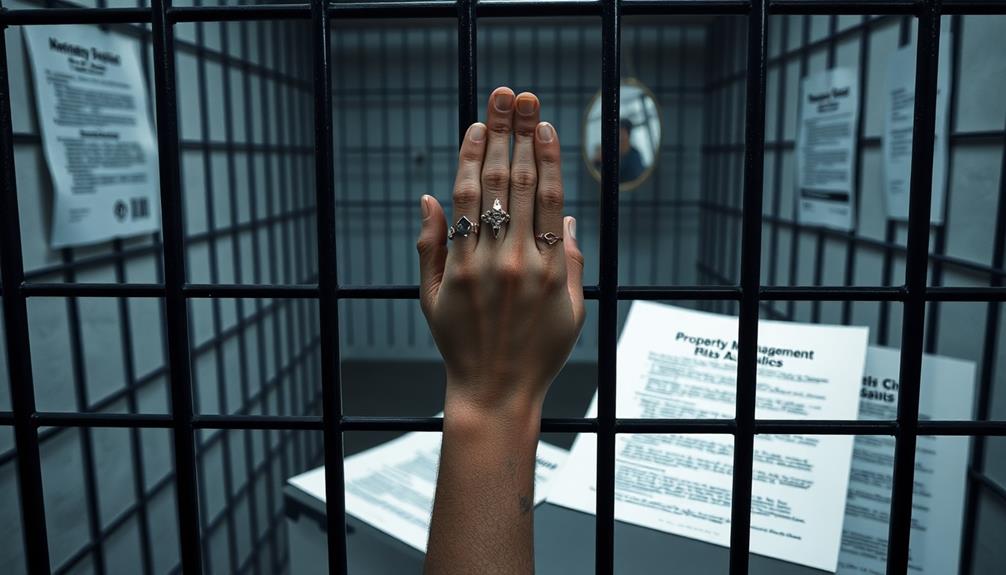
In prison, you need to understand the rules about what you can keep and how to manage your belongings.
You're allowed specific personal items based on your incentive level, and there are strict protocols for transferring property.
If something goes missing or gets damaged, you can file a complaint to address the issue.
Inmate Property Regulations
Many inmates face strict regulations regarding their personal property while incarcerated. Each facility has its own rules, which can vary greatly based on your incentive level. This can affect the number and type of items you're allowed to keep, including clothing and other personal belongings.
Property management policies require you to have all items recorded on a property card. You'll need to sign this card to acknowledge receipt of your belongings.
If you have excess property beyond the volumetric control limits—two standard boxes weighing no more than 15 kg each—you can request temporary storage from prison staff, but approval is essential.
Families are often limited to sending specific items, like books, while other personal property typically requires exceptional circumstances for approval.
If you experience lost or damaged property, you can file a complaint. Make sure to include detailed information about the items in your complaint, as the facility must respond within a specified timeframe.
Understanding these regulations can help you navigate the complexities of managing your property effectively while in prison.
Allowed Personal Items
Personal items allowed in prison vary greatly based on facility rules and your incentive level, which can range from standard to enhanced or basic. Each facility enforces specific regulations that dictate what you can keep.
For personal hygiene items, you'll need to adhere to strict design and branding restrictions to maintain security and safety.
Writing materials, books, and magazines are generally permitted across all incentive levels, allowing you to stay connected to the outside world. If you're at a higher incentive level, you might be able to enjoy additional items like musical instruments and hobby supplies, giving you a chance to express yourself creatively.
When it comes to clothing and footwear, the allowances can differ widely. Personal clothing may only be permitted at the governor's discretion, depending on your incentive level. Certain items, such as black clothing and stiletto heels, are outright banned.
Family and friends can send books, but other personal items usually require exceptional circumstances. Additionally, all incoming items need to fit within volumetric control limits for transfer, ensuring that your space remains organized and secure.
Property Transfer Protocols
Transferring property between facilities requires strict adherence to established protocols to guarantee that inmates' belongings are managed correctly. Each inmate must carry their property card during the transfer, confirming that a consistent record of personal items follows them.
Property bags must be secured with a unique security seal and shouldn't exceed 15 kg to comply with transfer regulations.
If you have excess property beyond these limits, it can be temporarily stored with the necessary approvals. You'll receive information about local storage arrangements upon your arrival at the new facility.
Here are some key points to remember about property transfers:
- The discharging prison is responsible for sending any excess property within four weeks, barring exceptional circumstances.
- If you experience issues, such as lost or damaged property during transfers, you can file a complaint through the prison complaints system. Make sure to include detailed information about the missing items, including purchase details and their value.
- Keeping your property organized and documented can prevent complications during transfers.
Understanding these protocols helps facilitate a smoother changeover for your belongings between facilities.
Clothing and Personal Item Rules

In prison, clothing and personal item rules are strictly enforced to maintain security and order. You'll typically wear prison-issued clothing, with any personal attire allowed at the governor's discretion based on your incentive level and specific prison rules.
Prohibited items include black garments, hoods, and padded clothing, while permitted footwear covers shoes, trainers, sandals, and slippers—stiletto heels and steel toe caps are off-limits.
For personal hygiene, you must stick to items that meet design and branding restrictions set by the prison. This guarantees they comply with security standards.
As for personal items, you can have essentials like writing materials, books, and magazines. If you show good behavior and reach higher incentive levels, you might earn the privilege to possess additional items, such as musical instruments and hobby supplies.
The prison's Incentives Policy Framework outlines the guidelines regarding what personal items you can have and how many, all depending on your behavior and incentive level.
Adhering to these rules is vital, as they directly impact your daily life and privileges while incarcerated.
Addressing Property Loss Concerns

Property loss can be a significant concern for inmates, especially when maneuvering strict rules around personal items. You may find that the procedures for addressing lost or damaged property are essential to understanding your rights. If you experience property loss, you can file a complaint through the prison complaints system. Be prepared to provide detailed information about the lost items, including purchase details and their estimated value.
Here are some key points to reflect on:
- Complaints about property lost during transfers are taken seriously, with a response time limit of 10 working days.
- The Prison Service usually doesn't accept responsibility for items lost unless it's due to staff negligence during transfers.
- If you're not satisfied with the response, you can appeal to the Prison and Probation Ombudsman or pursue claims through County Court.
To safeguard the security of your belongings, property checks should be conducted promptly in front of two staff members. Staying informed about these processes can help you navigate the complexities of property loss within the prison system.
Frequently Asked Questions
Are You Allowed to Wear Piercings in Prison?
You may not be allowed to wear metal piercings in prison due to security concerns. Some facilities permit non-metal alternatives, but it's essential to check specific regulations to understand what's acceptable in your location.
What Is a Secret Piercing?
Imagine wearing a mask at a masquerade; that's what a secret piercing feels like. It's a hidden expression of identity, often tucked away from view, allowing you to embrace individuality despite restrictions.
Can Prison Inmates Wear Jewelry?
No, prison inmates typically can't wear jewelry. Most facilities require them to remove all personal items, including jewelry, upon entry. This restriction limits self-expression and can negatively affect their psychological well-being during confinement.
Can I Wear Earrings in Prison?
Did you know that around 70% of prisons restrict metal items? You can't wear earrings in most facilities due to security policies, but some might allow non-metal options. Always check your prison's specific regulations.
Conclusion
To sum up, piercings in prison reveal much about inmates' identities and coping mechanisms. While regulations and health risks pose challenges, the cultural significance of these adornments can't be overlooked. Have you ever considered how something as simple as a piercing could symbolize resilience and individuality in such a restrictive environment? Understanding these layers helps us grasp the complexities of life behind bars, reminding us that even in confinement, self-expression persists.
Hi, my name is Danielle, and I’m an author for piercings-body.com. I have a passion for writing and love to share my knowledge on all things body piercing-related. I’m also a huge advocate for safe body modification practices and believe everyone should be able to make informed decisions about their bodies. When I’m not writing or blogging, I enjoy spending time with my family and friends, practicing yoga, and exploring new places.
Unique Piercing Contexts
How Different Professions View and Accommodate Piercings
The way professions view piercings can vary dramatically; discover how your career path may impact your personal expression and workplace acceptance.

Different professions view and accommodate piercings in diverse ways. In creative fields, you're likely to find acceptance and celebration of body modifications, which are seen as forms of self-expression. Meanwhile, conservative sectors, like finance and healthcare, often impose strict guidelines, favoring minimal or concealed jewelry to maintain a polished appearance. If you work in a service-oriented role, you may encounter a mix of acceptance and restrictions based on brand image. Understanding your industry's norms can help you navigate your personal style. Keep exploring to discover how workplace attitudes are evolving and what that means for you.
Key Takeaways
- Creative fields embrace body piercings as self-expression, with many professionals sporting multiple and exotic adornments.
- Conservative sectors prioritize professionalism, enforcing stricter guidelines that limit visible piercings to traditional styles.
- Healthcare regulations often require minimal and discreet jewelry to maintain hygiene standards.
- Government agencies impose strict appearance standards, favoring discreet jewelry in public service roles.
- Many workplaces are revising policies to accommodate body art, reflecting changing societal norms and increased acceptance.
Overview of Workplace Attitudes

Workplace attitudes toward piercings are evolving, with significant differences across various professions. In creative and youth-oriented fields, you'll likely find a more open mindset towards body art, including piercings. These industries appreciate self-expression, often welcoming employees who showcase their individuality through visible body modifications.
On the flip side, conservative sectors like banking and government agencies tend to enforce stricter dress codes that limit or prohibit visible piercings. Although around 40% of Millennials have at least one tattoo and 30% have piercings beyond traditional ear piercings, acceptance still varies. Many employers recognize that visible body art doesn't negatively impact hiring decisions; however, about 37% express hesitance to promote those with noticeable piercings.
Dress codes play a vital role in shaping workplace attitudes. Some companies allow a limited number of piercings, while others maintain stringent guidelines against excessive or visible body art.
As organizations increasingly revise their appearance policies to reflect Millennial preferences, you can expect attitudes to shift further, promoting a culture of inclusivity and acceptance in the workplace.
Industry-Specific Acceptance

When you explore industry-specific acceptance of piercings, you'll notice a stark contrast between creative fields and conservative sectors.
In fashion and entertainment, multiple styles thrive, while finance and government roles often impose strict restrictions.
Understanding these differences can help you navigate your own choices in self-expression within various professional environments.
Creative Industries Embrace Modifications
Creative industries like fashion, music, and advertising have thrown open the doors to body modifications, embracing piercings as a vibrant form of self-expression. In these fields, you'll often find that multiple piercings and unique styles are celebrated, reflecting a culture that values individuality.
For instance, the influence of celebrity lifestyles often sets trends that encourage personal expression through body art. Employers prioritize skills and creativity over appearance, leading to relaxed dress codes that welcome personal expression.
Interestingly, about 30% of Millennials in creative roles sport piercings beyond the traditional ear variety, showcasing a significant shift in workplace norms. This acceptance allows you to showcase your personality through your body art, whether it's tattoos or piercings.
Additionally, the rise of influencer culture has further normalized visible body modifications, inspiring organizations to embrace diverse aesthetics. As you navigate your career in a creative field, you'll likely feel empowered to express yourself freely without fear of judgment.
Ultimately, these industries not only recognize the importance of creativity but also celebrate the unique identities of their members, encouraging you to wear your modifications proudly.
Conservative Sectors' Restrictions
While many industries celebrate personal expression through piercings, conservative sectors often impose strict restrictions that prioritize a polished appearance. In these environments, body piercings are perceived as distractions that could undermine professionalism. For instance, workplaces in sectors like sales and banking typically limit visible piercings to traditional ear piercings.
| Sector | Piercing Acceptance |
|---|---|
| Sales | Only traditional ear piercings |
| Banking | Minimal visible piercings |
| Healthcare | Concealed jewelry preferred |
| Corporate Offices | Limited piercings per ear |
These policies reflect a desire for uniformity and professionalism over individual expression. In healthcare, hygiene concerns further tighten restrictions, as employers often require minimal or concealed jewelry. Some conservative workplaces may allow a limited number of piercings per ear, signaling a slight compromise. Overall, in conservative sectors, the acceptance of piercings is generally limited, with employers prioritizing a traditional image above personal style.
Government Agency Standards
Government agencies often uphold strict appearance standards that reflect a traditional view of professionalism, even as they embrace progressive values in other areas. In these settings, explicit dress codes frequently restrict visible tattoos and excessive piercings to maintain a polished image.
While some federal offices may allow a limited number of piercings per ear, the overall tendency is to favor a more conservative approach.
Hygiene concerns play a considerable role, especially in government roles related to public service and safety. These concerns influence how piercings are perceived, leading many employees to choose more discreet options.
You might find that the type and visibility of your jewelry can considerably impact your professionalism in these environments.
In essence, if you're considering a job in a government agency, it's wise to be mindful of their appearance standards. While personal expression is valued in many sectors, government settings often prioritize a conservative image.
Understanding these nuances will help you navigate the complexities of workplace expectations related to piercings and visible tattoos.
Common Piercings by Profession

When you think about piercings in different professions, it's clear that acceptance levels vary widely.
In creative fields, you might see multiple piercings as a personal statement, while healthcare roles often require a more conservative approach.
Let's explore which piercings are most popular in various industries and how they reflect each profession's culture.
Industry-Specific Acceptance Levels
Acceptance of piercings varies considerably across different professions, reflecting the cultural norms and expectations inherent in each field. In creative industries like fashion and advertising, multiple piercings, including nose and septum piercings, are often celebrated as expressions of individuality.
However, in conservative sectors such as banking, only simple ear piercings may be deemed acceptable.
The healthcare industry tends to enforce stricter policies regarding visible piercings due to hygiene concerns. Here, minimal and discreet jewelry is favored, while roles in the arts or tech sectors embrace more expressive body art.
In the service industry, especially customer-facing positions, small, unobtrusive piercings might be accepted, but visible tattoos and excessive piercings are often prohibited to maintain a polished appearance.
Government agencies generally uphold conservative standards, restricting visible piercings unless they're culturally or religiously significant.
Conversely, corporate environments are increasingly recognizing piercings as acceptable forms of self-expression. Yet, acceptance levels still vary widely, with many offices allowing only a limited number of piercings per ear while prioritizing professionalism.
Understanding these industry-specific acceptance levels can help you navigate workplace expectations effectively.
Popular Piercings by Profession
Many professionals across various fields embrace specific piercings that reflect their industry culture and personal style.
If you work in a creative sector like fashion or media, you'll likely see colleagues flaunting multiple and exotic body piercings, showcasing their unique flair.
In contrast, if you're in healthcare, you might notice most medical professionals sticking to minimal jewelry, such as simple ear studs, to maintain hygiene standards.
Corporate environments, particularly in finance and law, often favor conservative styles, limiting visible piercings to standard ear lobe adornments.
However, in service-oriented professions like hospitality and retail, there's a shift towards acceptance. Employees often sport tasteful piercings that align with the brand's image, demonstrating a blend of professionalism and personal expression.
In technical fields like IT and engineering, there's usually more leeway for body piercing, allowing you to express yourself without stringent appearance regulations.
- Creative industries: Multiple and exotic piercings
- Healthcare sector: Minimal jewelry, like ear studs
- Corporate environments: Discreet and professional styles
Concealing Piercings at Work
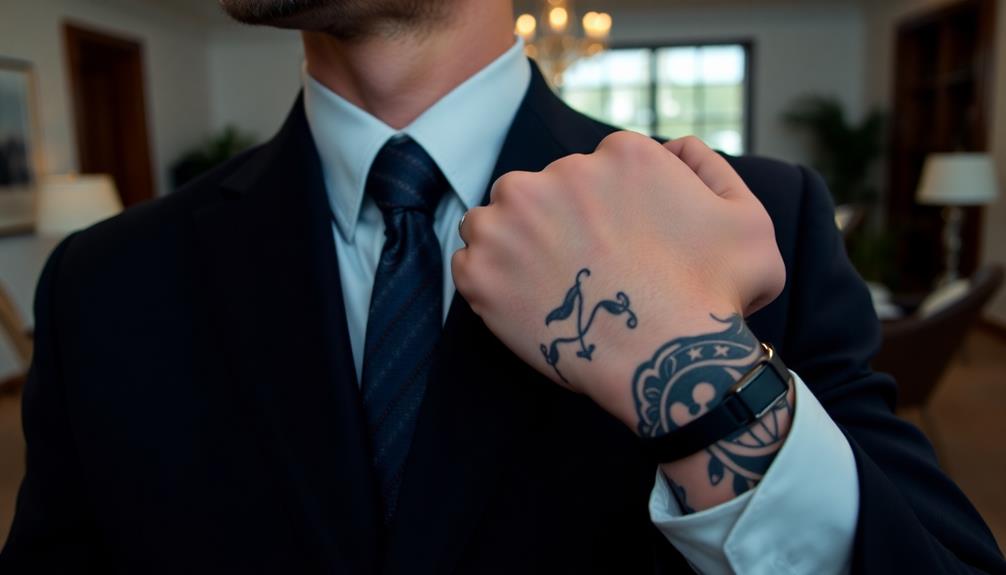
In today's professional landscape, concealing piercings at work has become a necessity for those who want to maintain a polished appearance in conservative environments. For instance, if you have ear piercings, styling your hair can effectively cover them, allowing you to blend into a formal setting.
If you sport a curved septum barbell, you can flip it up into your nostrils when needed, providing a discreet option during essential meetings.
When it comes to piercings in hidden areas, such as navel or nipple piercings, you typically won't face visibility issues. However, eyebrow and lip piercings can be more challenging to conceal without drastic measures, making them less suitable for workplaces with strict appearance standards.
For piercings like the tongue or frenulum, it's vital to maintain careful mouth control to avoid revealing the jewelry while you converse.
Ultimately, being aware of how to conceal your piercings at work can help you navigate professional environments without compromising your personal style.
Whether through strategic hair styling or choosing less conspicuous body modifications, you can maintain your individuality while adhering to workplace expectations.
Policies on Body Modifications

Workplace policies on body modifications vary considerably across industries, impacting how employees express their individuality. In conservative fields like finance and government, you might find strict rules limiting visible piercings and tattoos. On the other hand, creative sectors tend to embrace more freedom in body art, allowing for greater personal expression.
Here are some key points to reflect on:
- Many workplaces have explicit dress codes addressing body modifications.
- Research shows 31% of employers are hesitant to promote employees with visible tattoos, while 37% share similar concerns about piercings.
- Federal offices generally don't factor piercings into hiring decisions, reflecting varying acceptance levels.
As companies evolve, some are revisiting their policies to better accommodate body art. They're even implementing diversity and inclusion training to foster an environment where personal expression is recognized.
However, if you're maneuvering a corporate environment, it's essential to understand these policies, as they can greatly influence your career path. Balancing your desire for self-expression with workplace expectations can be a delicate act, but being informed helps you make the right choices.
Legal Considerations

Maneuvering the legal landscape surrounding body modifications like piercings and tattoos can be tricky for both employees and employers. While tattoos and piercings aren't considered fundamental constitutional rights, employers can enforce appearance regulations if they deem it necessary for professionalism.
For instance, California recognizes tattoos as protected speech under the First Amendment, which may shape how employers craft their policies on body art. Additionally, understanding the potential impact of divorce rates on personal expression in the workplace may influence company culture and policies.
Employers are legally allowed to impose reasonable appearance standards; however, these standards must be balanced against potential discrimination claims related to visible body art. Notable cases, like Scavone v. Pennsylvania State Police, highlight how courts have upheld employer rights to reject candidates based on visible tattoos or piercings. This illustrates the complex legal considerations both sides face.
As many companies lean towards a more inclusive approach to body art, some still maintain strict policies that can affect hiring and promotion opportunities.
This ongoing tension between personal expression and professional appearance underscores the importance of understanding the legal framework surrounding body modifications. Ultimately, both employees and employers must navigate these legal waters carefully to avoid disputes and guarantee fairness in the workplace.
Future Trends in Body Art

As societal norms continue to evolve, the acceptance of body art, particularly piercings, is becoming more prominent in professional settings. You might notice that Millennials and Generation Z are leading this cultural shift, with a significant percentage choosing to express themselves through body art. This trend indicates a change in how workplaces perceive personal expression.
- Increased visibility of piercings in creative industries: Fields that encourage individuality are more likely to embrace diverse appearances.
- Evolving dress codes: Many employers are revising policies, recognizing that skills and qualifications should outweigh personal appearance.
- Legal protections for body art: As some states classify tattoos as protected speech, future policies may further support body art in the workplace.
However, tensions still exist. Research shows that while acceptance is growing, many employers remain hesitant about visible tattoos and piercings when it comes to promotions.
As you navigate your career, be mindful that while acceptance is on the rise, traditional norms still play a role in how body art is viewed in various professions. The future seems promising, but change won't happen overnight.
Tips for Professionals

Maneuvering the world of piercings in a professional setting can be tricky, but with the right approach, you can express your individuality while still making a strong impression.
Start by observing your workplace's norms regarding piercings. In creative industries like fashion, ear piercings and other visible adornments may be celebrated. However, in conservative fields such as finance, you might face stricter dress codes. Being aware of how personal expression, such as piercings, can impact perceptions in the workplace is essential for maintaining professionalism and narcissistic behavior can lead to occasional misunderstandings about personal choices.
Before your first day, take note of the type of jewelry your colleagues wear. This common sense observation can help you gauge what's acceptable. If you're in a conservative environment, opt for simple and discreet jewelry, like studs or small hoops. These choices minimize scrutiny while allowing you to showcase your style subtly.
If you have visible piercings, consider using long hair to cover earrings or wearing jewelry that can be flipped up, such as curved septum barbells. This tactic can maintain a professional appearance.
Frequently Asked Questions
How Are People With Piercings Perceived?
People perceive you with piercings in varied ways; some admire your self-expression, while others might judge you based on traditional standards. Ultimately, their views depend on personal biases and the context of your appearance.
What Professions Allow Piercings?
In a world where expressions shine like stars, creative fields such as fashion and tech often welcome piercings. Service industries usually embrace individuality too, while healthcare and corporate roles remain more cautious about visible adornments.
How Do Jobs Feel About Piercings?
Jobs often have mixed feelings about piercings. While some embrace individuality, others see them as unprofessional. It's essential to know your workplace's culture and policies before deciding how to express your personal style.
Can Jobs Discriminate Against Piercings?
Yes, jobs can discriminate against piercings. Employers often enforce appearance policies, and while some sectors are more accepting, others may view visible piercings as unprofessional, impacting your promotion opportunities and overall job prospects.
Conclusion
In today's diverse work environment, embracing individuality through piercings can enhance your personal expression without compromising professionalism. While some might worry that piercings could hinder career advancement, many industries are becoming more accepting of body art. By understanding your workplace's culture and policies, you can confidently showcase your style. Remember, it's all about balance—keeping your unique flair while respecting your professional setting. So go ahead and express yourself; your talents are what truly matter!
Hi, my name is Danielle, and I’m an author for piercings-body.com. I have a passion for writing and love to share my knowledge on all things body piercing-related. I’m also a huge advocate for safe body modification practices and believe everyone should be able to make informed decisions about their bodies. When I’m not writing or blogging, I enjoy spending time with my family and friends, practicing yoga, and exploring new places.
-
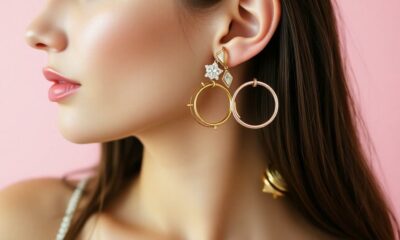
 Style and Fashion4 weeks ago
Style and Fashion4 weeks agoCreative Ways to Showcase Multiple Ear Piercings
-
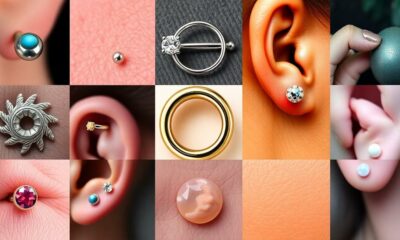
 Style and Fashion4 weeks ago
Style and Fashion4 weeks agoPiercing Jewelry Materials: Pros and Cons for Different Skin Types
-

 Style and Fashion4 weeks ago
Style and Fashion4 weeks agoHow to Coordinate Your Piercings With Your Personal Style
-
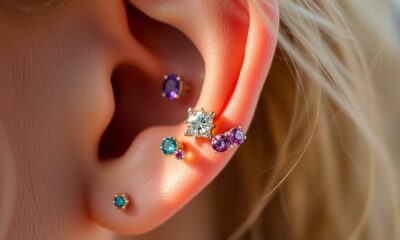
 Style and Fashion4 weeks ago
Style and Fashion4 weeks agoIncorporating Birthstones Into Your Piercing Jewelry
-

 Style and Fashion4 weeks ago
Style and Fashion4 weeks agoHow to Style Piercings for Formal Events and Weddings
-
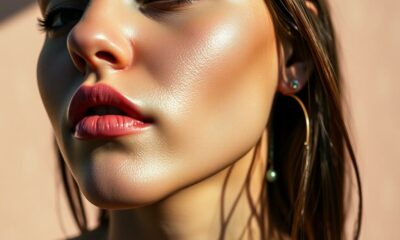
 Style and Fashion3 weeks ago
Style and Fashion3 weeks agoHow to Photograph Your Piercings for Social Media
-

 Style and Fashion3 weeks ago
Style and Fashion3 weeks agoThe Impact of Face Shape on Ideal Piercing Placements
-

 Style and Fashion3 weeks ago
Style and Fashion3 weeks agoMixing Piercing Styles: Bohemian, Minimalist, and Edgy Looks









